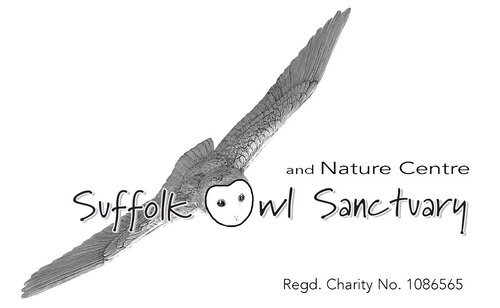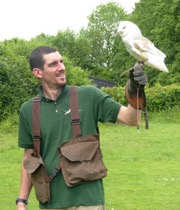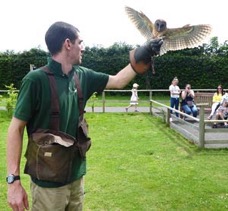From Easter until the last weekend in September, life at S.O.S. becomes hectic for falconers and their charges! Three flying demonstrations are the focus of our visitors' attention, but the shows have to be fitted in between the always busy schedule of cleaning aviaries, feeding birds and maintaining their fitness levels, engaging with school parties and most importantly receiving, assessing, treating and rehabilitating injured wild owls and other birds of prey in the raptor hospital.
As a charity, we manage this packed daily schedule on a precarious budget, substantially dependent on public donations. Consequently, we are indebted to our small army of volunteer helpers who work tirelessly (in all weathers!) to assist with all aspects of the falconers’ workload, rewarded only with the opportunity to get close to, handle and fly some of the sanctuary’s resident birds.
Volunteer Tom gets down to the nitty gritty -
papering night boxes in the mews room
Some volunteers work with us for many years, having found a niche in which they feel fulfilled; happy to help, in close proximity to the birds that they feel so passionate about. Other individuals wish to just dip into the work of the sanctuary for a few months to experience something out of the ordinary and gain skills that would otherwise have remained outwith their ken.
Volunteers come from diverse backgrounds and all walks of life; students, nurses, policemen, service personnel, entrepreneurs, carers and their charges, full time grannies and those enjoying retirement. A wide variety of nationalities have also enriched the sanctuary’s cultural diversity over the years and we have received assistance from individuals from Spain, Italy, Sweden, Poland and the Netherlands.
At the end of a hard day’s work Tom winds down helping to exercise Cobweb the Barn
Owl and Taino the Ashy Faced Owl.
In this context, volunteers not only contribute practical help, experience and wisdom to the day to day running of the sanctuary, they also offer another perspective on life in general and our role in the wider context of local community and international conservation issues.
It is not only in the summer season that volunteers are so valuable to the management of the centre’s workload. During the winter months, when there are no demonstrations and the flying team rest and moult, the chores continue as the standard of care of the centre’s 80+ resident birds must still be upheld.
That the sanctuary could not run efficiently without the dedication of volunteers is an understatement.Through all seasons and in all weathers, our volunteers are crucial to the successful running of the sanctuary and the happy and healthy lives of the birds. From sweeping paths, to weighing birds, to clearing undergrowth - even to serving hot chocolate and mince pies during our annual Christmas event - all volunteers are priceless and we thank them all most sincerely for their help.
Anyone interested in offering their services in this capacity would be most welcome - especially if they have time to spare at weekends! The only criteria are that interested applicants be consistent in their attendance, willing to turn their hand to all tasks and have a sense of humour and love of a frequent hot beverage! Further details can be obtained from volunteer co-ordinator, Liz Boyd via the the admin. office on 0345 680 7897, by email to liz@owlbarn.co.uk or from the sanctuary’s reception desk.
We look forward to meeting you!






















































